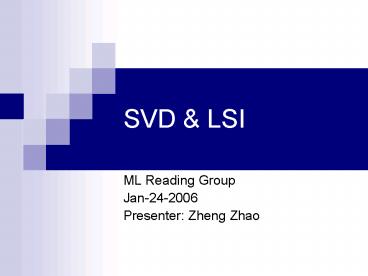SVD - PowerPoint PPT Presentation
1 / 27
Title: SVD
1
SVD LSI
- ML Reading Group
- Jan-24-2006
- Presenter Zheng Zhao
2
SVD (Singular value decomposition)
- Vector Norm
- Matrix Norm
- Singular value decomposition
- The application of SVD
3
vector norm
- A vector norm has the following properties.
- 1. x ? 0 (non-negative)
- 2. x 0 implies that all elements xi 0
- 3. ?x ? x
- 4. x1 x2 ? x1 x2
(triangular inequality) - Equivalence of norms
4
vector norm (cont.)
5
matrix (operator) norm
- A matrix (operator) norm has the following
properties. - 1. A ? 0 (non-negative)
- 2. A 0 implies that all elements xi 0
- 3. ?A ? A
- 4. A1 A2 ? A1 A2
(triangular inequality) - 5. AB ? A B (multiplicative
property)
An induced norm is defined as the following, for
z Ax
measures how much A stretches x
6
matrix (operator) norm (cont.)
7
SVD
- SVD- Singular value decomposition
- http//en.wikipedia.org/wiki/Singular_value_decomp
osition
8
Some Properties of SVD
9
Some Properties of SVD
- That is, Ak is the optimal approximation in terms
of the approximation error measured by the
Frobenius norm, among all matrices of rank k - Forms the basics of LSI (Latent Semantic
Indexing) in informational retrieval
10
Application of SVD
- Pseudoinverse
- Range, null space and rank
- Matrix approximation
- Other examples
- http//en.wikipedia.org/wiki/Singular_value_decomp
osition
11
LSI (Latent Semantic Indexing)
- Problem Introduction
- Latent Semantic Indexing
- LSI
- Query
- Updating
- An example
- Some comments
12
Problem Introduction
- Traditional term-matching method doesnt work
well in information retrieval - We want to capture the concepts instead of words.
Concepts are reflected in the words. However, - One term may have multiple meaning
- Different terms may have the same meaning.
13
LSI (Latent Semantic Indexing)
- LSI approach tries to overcome the deficiencies
of term-matching retrieval by treating the
unreliability of observed term-document
association data as a statistical problem. - The goal is to find effective models to represent
the relationship between terms and documents.
Hence a set of terms, which is by itself
incomplete and unreliable, will be replaced by
some set of entities which are more reliable
indicants.
14
LSI, the Method
- Document-Term M
- Decompose M by SVD.
- Approximating M using truncated SVD
15
LSI, the Method (cont.)
Each row and column of A gets mapped into the
k-dimensional LSI space, by the SVD.
16
Fundamental Comparison Quantities from the SVD
Model
- Comparing Two Terms the dot product between two
row vectors of reflects the extent to which
two terms have a similar pattern of occurrence
across the set of document. - Comparing Two Documents dot product between two
column vectors of - Comparing a Term and a Document
17
Query
- A query q is also mapped into this space, by
- Compare the similarity in the new space
- Intuition Dimension reduction through LSI brings
together related axes in the vector space.
18
Updating
- Recomposing
- Expensive
- Fold in Method
New terms and documents have no effect on the
representation of the preexisting terms and
documents
19
Example
20
Example (cont.)
21
Example (cont. Mapping)
22
Example (cont. Query)
Query Application and Theory
23
Example (cont. Query)
24
Example (cont. fold in)
25
Example (cont. recomposing)
26
Choosing a value for k
- LSI is useful only if k ltlt n.
- If k is too large, it doesn't capture the
underlying latent semantic space if k is too
small, too much is lost. - No principled way of determining the best k need
to experiment.
27
How well does LSI work?
- Effectiveness of LSI compared to regular
term-matching depends on nature of documents. - Typical improvement 0 to 30 better precision.
- Advantage greater for texts in which synonymy and
ambiguity are more prevalent. - Best when recall is high.
- Costs of LSI might outweigh improvement.
- SVD is computationally expensive limited use for
really large document collections - Inverted index not possible































